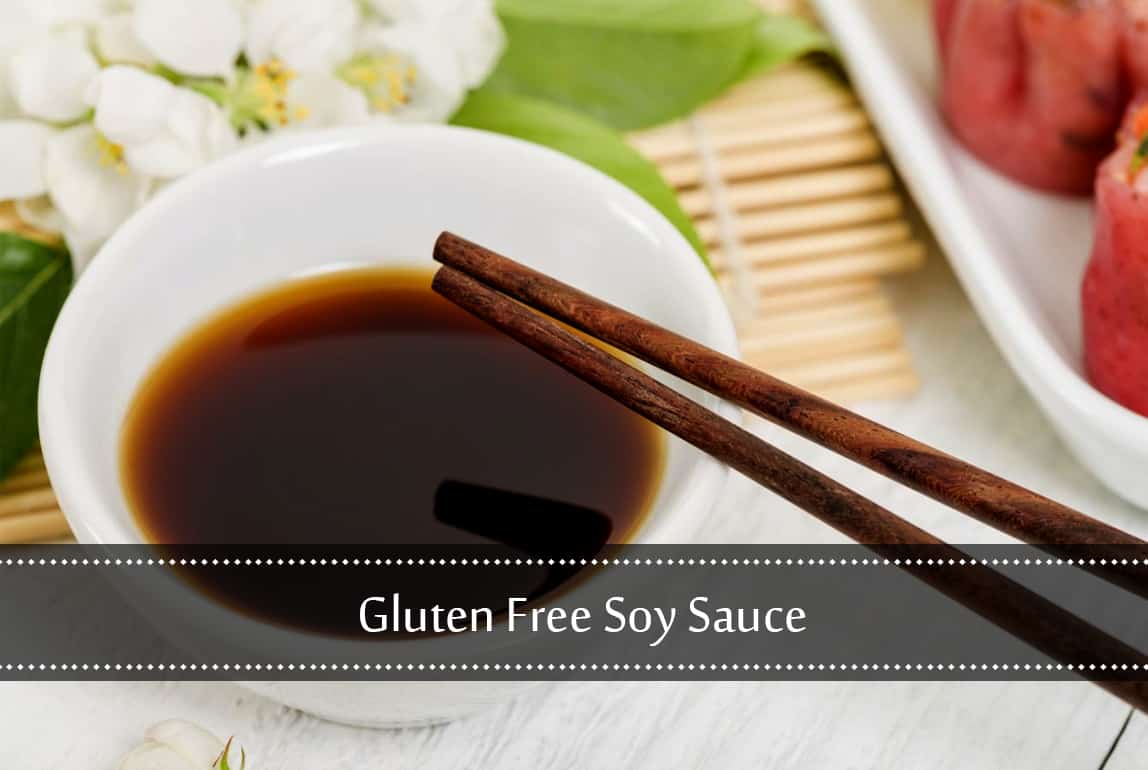For those of you who follow a gluten-free diet, soy sauce is a staple. You can’t have sushi without it! Gluten-free soy sauces are made from beans or vegetables instead of wheat and barley, so they’re great for anyone with this allergy.
Why is soy sauce not gluten-free?
Soy sauce is not gluten-free because wheat is used in the process. The fermentation of soybeans and wheat produces soy sauce. Crushed soybeans, crushed wheat, water, and the presence of fermentation cultures ensure quality, purity, and, above all, health. Vitamin B12 is produced during fermentation, and carbohydrates, fats, and proteins are broken down, including gluten, as confirmed by several experts.
Because of this, Gluten-free soy sauce is a tricky thing. Many brands are not that good and have high levels of salt or sugar, but we found 8 great-tasting gluten-free soy sauces for you!
Gluten-free Soy Sauce Alternatives
Kikkoman Gluten-Free Soy Sauce: This is by far my favorite gluten-free soy sauce on the market. It is a bit more expensive than the normal kind, but it is also the closest to the real thing.
Ingredients: Water, rice, soy, salt.
Lee Kim Kee Gluten-Free Soy Sauce: This is another brand that I usually buy and a close second to Kikkoman. The brand claims to produce the sauce with non-GMO whole soybeans. This sauce is also very close to the taste of the original.
Ingredients: Water, soybeans, salt, sugar, corn starch.
Sempio Soy Sauce: This soy sauce alternative is made in South Korea. It does taste a bit different than soy sauce. I include it in the list because gluten-free soy sauce can be hard to find and I rather have Sempio than nothing at all.
Ingredients: Water, soybeans, salt, spirits (alcohol).
Organic Coconut Aminos Soy Sauce Replacement: This is not really soy sauce, but instead a low sodium replacement for it. It’s gluten-free and paleo-friendly.
This sauce is made from organic coconut blossom nectar and Himalayan salt. This makes the sauce a bit sweeter than regular soy sauce.
It is an OK replacement if you can’t eat soy or high sodium foods.
Ingredients: Organic Coconut Blossom Nectar (sugar), Himalayan Salt.
Gluten-free Tamari Soy Sauce
Tamari is a Japanese soy sauce, traditionally made as a byproduct of miso paste. The main difference between regular soy sauce and tamari soy sauce is the lack of wheat in the fermentation process, making it gluten-free.
Traditional Chinese soy sauce is light, thin, and salty. Tamari soy sauce is gluten-free, darker, less salty, and has a strong umami flavor, which makes it great for dipping.
Tamari has a higher soybean content than other soy sauces, giving it a fuller flavor. It also retains flavor when cooked. It is perfect for stir-fries, teriyaki, dipping, and soups.
Kikkoman Tamari Gluten-Free Soy Sauce: This is another great soy sauce presentation by Kikkoman. It is super flavorful, you can taste the umami, and best of all, it is gluten-free, non-GMO, and vegan. Tamari is more balanced in flavor, richer, and less salty.
Kikkoman Tamari Gluten Free Soy Sauce contains no artificial additives, colorings, or alcohol, the sauce is slowly matured using a special brewing process without wheat.
Ingredients: Water, soybeans, salt, sugar.
San-J Tamari Gluten-Free Soy Sauce: This Japanese soy sauce is made from the highest quality soybeans and without wheat. San-J Tamari is a great choice for gluten-free eaters in search of an excellent alternative to typical soy sauce.
It has no artificial preservatives or additives.
Ingredients: Water, soybeans, salt, alcohol (to preserve freshness).
Sanchi Tamari Soy Sauce: Sanchi naturally brewed gluten-free Tamari Soy Sauce is a traditional Japanese product. This sauce has no artificial preservatives, vegan.
Ingredients: Soya Beans (49%), Water, Salt, Distilled Alcohol (from Sugar Cane), Koji Seed (Aspergillus Oryzae)
San J Tamari Gluten-Free Soy Sauce, Reduced Sodium: Same great taste and quality from San J, but reduced in Sodium. San J claims on their site that this product is also kosher and non-GMO.
Ingredients: Water, soybeans, salt, alcohol (to preserve freshness).
GANKO TAMARI SHOYU: This is a tamari dark soy sauce that is made with kioke wooden barrels – brewed (or fermented) thoroughly in a cedar barrel for 3 years. It is gluten-free, fat-free, low calories, and has no additives.
This is a family ran brewery. The flavor secrets have been passed down to 9 generations since 1818.
Ingredients: Soybeans, salt.
Pacific Island Soy Sauce: This American Made Soy Sauce is Fat-Free, Gluten-Free, has no sugars, it’s Non-GMO. Corn-Free, Vegan-Friendly no animal products, No Preservatives, no harmful chemicals. Naturally Fermented for healthy consumption, 50% lower sodium than the lightest real soy sauce.
Ingredients: Water, tamari soy sauce, lemon juice, distilled vinegar, green onion extract, and jalapeno extract.
Gluten-free Soy Sauce FAQs
Is soy sauce gluten-free?
Traditional soy sauce is not gluten-free. Chinese soy sauce is made by fermenting one-to-one rations of soybeans and wheat.
There is however a popular Japanese soy sauce by the name of Tamari that is gluten-free. This type of soy sauce is typically made by only fermenting soybeans. Tamari is a byproduct of miso. This soy sauce is pressed from the liquid that drains from a miso paste (fermented soybean paste) as it ages.
Even though traditional Tamari doesn’t use gluten, some brands might use a small amount or might have cross-contamination. It is always suggested that you read the ingredient list and ensure the soy sauce is properly labeled as gluten-free.
What type of soy sauce is gluten-free?
Tamari sauce is usually gluten-free. This Japanese traditional soy sauce is made without gluten. This soy sauce is the liquid that drains from miso paste as it is pressed. I always advise you to read the label for any gluten ingredients and ensure the product is properly labeled as gluten-free.
Is there a gluten-free substitute for traditional soy sauce?
Some companies make soy sauce substitute from coconut aminos. These aminos are a popular soy sauce substitute made from fermented coconut palm sap. It’s an alternative that is wheat and gluten-free. Because of the ingredients and process used it is much lower in sodium than soy sauce and a bit sweeter. This soybean substitute is a good alternative.
Is Kikkoman soy sauce gluten-free?
Regular Kikkoman soy sauce is not glute-free. Their regular soy sauce is fermented with soybeans and wheat, but they make have a few gluten-free soy sauces available.
I mention my two favorites in this article if you are interested in looking into them.
What are the ingredients in gluten-free soy sauce?
The ingredients in gluten-free soy sauce are soybeans, water, salt, and in some cases alcohol to preserve freshness. Some soy sauces might contain sugar as well. Ingredients in soy sauce substitutes, those that are not made from soybeans, include coconut aminos, sugar, water, and salt.
Is lee kum kee soy sauce gluten-free?
Lee Kum soy sauce is not gluten-free. The sauce is made with water, salt, soybeans, sugar, wheat flour, and other flavor enhancers. As this sauce is fermented with flour, it is not considered gluten-free.
Is mushroom soy sauce gluten-free?
Mushroom soy sauce is not gluten-free. Mushroom soy sauce is a type of dark soy sauce. It is made with traditional soy sauce infused with the essence of straw mushrooms, or sometimes shiitake mushrooms. Traditional soy sauce is made by fermenting one to one ration of soybeans and wheat.
Is shoyu gluten-free?
Shoyu is not gluten-free. It is basically the term used for Japanese-style soy sauces. Shoyu is made from fermented soybeans, wheat, salt, and water.
Is ponzu sauce gluten-free?
Ponzu sauce is not gluten-free. This classic Japanese condiment is made with citrus juice of sudachi, yuzu, kabasu, vinegar, soy sauce, sugar, or mirin, and dashi. Because one of the ingredients is soy sauce, it is not gluten-free. Soy sauce is made by fermenting one-to-one parts of soybeans and wheat.
Is Japanese soy sauce gluten-free?
Not all Japanese soy sauce is gluten-free. Shoyu is not gluten-free, but Tamari is gluten-free. I suggest you always check the label for gluten ingredients and ensure the bottle is properly labeled as gluten-free before you purchase.
Is Chinese soy sauce gluten-free?
Traditional Chinese sauce is not gluten-free. There are gluten-free alternatives that some brands sell. I suggest you check the label for gluten and ensure the product is properly labeled as gluten-free before you purchase.
Is Korean soy sauce gluten-free?
Traditional Korean soy sauce is not gluten-free. The ingredients in Korean soy sauce include water, defatted soybeans, wheat, salt, high-fructose Corn Syrup, yeast extract, licorice extract, and sucralose. Because it is made with wheat it contains gluten and is therefore not gluten-free.
There are gluten-free Korean soy sauces available though. Chosun Ganjang is a traditional Korean soy sauce made from soybeans, salt, and water. The link takes you to an amazon link that sells Sempio’s version of this type of sauce.
Is la Choy soy sauce gluten-free?
Yes, La Choy soy sauce is gluten-free. La Choy soy sauce is made with water, salt, hydrolyzed soy protein, corn syrup, caramel color, and potassium sorbate as preservatives. They advertise this list of Gluten-free La Choy products on their website as gluten-free, including their soy sauce.
What are the gluten-free soy sauce ingredients?
Gluten-free soy sauce ingredients include water, soybeans, salt, alcohol to preserve freshness, and sometimes sugar.











